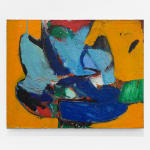




Wook-Kyung Choi
Untitled, Year unknown
Oil on canvas
18.11 x 22.83 inches
46 x 58 cm
46 x 58 cm
Further images
Choi's paintings are in dialogue with her own destiny shaped by her own personality. Living like a true artist, Choi had to cope with natural conflicts with "rationality" demanded by social structure." Choi's already sensitive and fragile personality is further enhanced by the sense of her insecurity and displacement from her surroundings. Those inner senses had her to have a pessimistic view on a world, yet they were also sources of creativity and experiments Choi pursued throughout her short artistic career. All of her engagements with her own and the world are faithfully transformed into energetic brushstrokes and bright colors of ink or sometimes in everyday materials such as newspaper or magazines, in abstract and expressive form.
A sense of dislocation and loss in America was no different from those in Korea. If she encountered political and social outrage such as racism, Cold War, Vietnam War, and rising discussion of gender and sex in America, she was abandoned by her own society in Korea as a female artists working in a modern visual language for her own. One can argue that the fundamental characteristic of Choi as pessimism. Yet this does not come from her negative perspective on the world, but a conflict between her and what she regarded the system of the world as irrational. The dynamic nature of her paintings and collage works reflect this conflict--sometimes meditative and melancholy, but other times furious and anguish. The visual language of abstraction is used for her and viewers to encounter those senses, which are very much intended but not so easily attainable.
Choi is unique in that she was never a part of any particular group of Korea, which is dominated by newly emerging performance and installation art, dansaekhwa, or minjoong. If there was abstraction, it was only discussed in terms of trauma of war (Art Informel), theoretical frame of autonomy of art (Greenberg), or going back to tradition (Dansaekhwa). Scarcity of artists who took on visual language of Abstract Expressionism for their own interest, as well as being a female artist in Korea further provided Choi handicap in her career. Nevertheless, she continued to produce the work that would become historically significant in both society of Korea and America and stand as a unique figure.
Choi's paintings are in dialogue with her own destiny shaped by her own personality. Living like a true artist, Choi had to cope with natural conflicts with "rationality" demanded by social structure." Choi's already sensitive and fragile personality is further enhanced by the sense of her insecurity and displacement from her surroundings. Those inner senses had her to have a pessimistic view on a world, yet they were also sources of creativity and experiments Choi pursued throughout her short artistic career. All of her engagements with her own and the world are faithfully transformed into energetic brushstrokes and bright colors of ink or sometimes in everyday materials such as newspaper or magazines, in abstract and expressive form.
A sense of dislocation and loss in America was no different from those in Korea. If she encountered political and social outrage such as racism, Cold War, Vietnam War, and rising discussion of gender and sex in America, she was abandoned by her own society in Korea as a female artists working in a modern visual language for her own. One can argue that the fundamental characteristic of Choi as pessimism. Yet this does not come from her negative perspective on the world, but a conflict between her and what she regarded the system of the world as irrational. The dynamic nature of her paintings and collage works reflect this conflict--sometimes meditative and melancholy, but other times furious and anguish. The visual language of abstraction is used for her and viewers to encounter those senses, which are very much intended but not so easily attainable.
Choi is unique in that she was never a part of any particular group of Korea, which is dominated by newly emerging performance and installation art, dansaekhwa, or minjoong. If there was abstraction, it was only discussed in terms of trauma of war (Art Informel), theoretical frame of autonomy of art (Greenberg), or going back to tradition (Dansaekhwa). Scarcity of artists who took on visual language of Abstract Expressionism for their own interest, as well as being a female artist in Korea further provided Choi handicap in her career. Nevertheless, she continued to produce the work that would become historically significant in both society of Korea and America and stand as a unique figure.
Provenance
Acquired directly from the artist's estate




